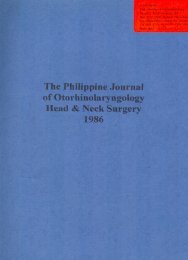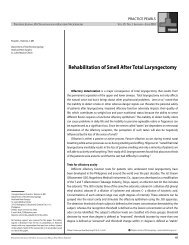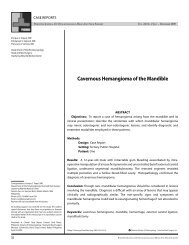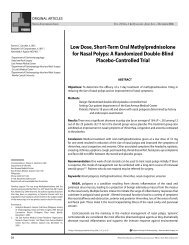Create successful ePaper yourself
Turn your PDF publications into a flip-book with our unique Google optimized e-Paper software.
This study presents variations with regard to contemplates designing a cannula specifically for<br />
measurements of anatomical structures in the lateral Filipinos.<br />
nasal wall among Caucasians and Filipinos. Consid- Myerson (1931) stated that the maxillary ostium<br />
eration of this observation must be borne in mind in occupies a vertical, horizontal, or oblique position in<br />
doing nasal surgery as well as in designing instruments the infundibulum. He was able to cannulate successfor<br />
use in Filipino patients, fully 138 of 170 maxillary ostia (82%). Ninety-eight<br />
A discussion of the antomic variations found in (71%) were verticall placed, 34 (25%) horizontal, and<br />
the study will be presen_ted. 6 (4%) were obliquely placed. Comparing these with<br />
the results of this study, 28 (56%) were vertically<br />
A. Absence of the supreme turbinate placed, 13 (26%) horizontal and 9 (18%) were obliquely<br />
Schaeffer (1916) cited the presence of the supreme placed. This variation in position among Filipinos<br />
turbinat.e either unilaterally or,bilaterally in 60% of should be borne in mind in any attempt to catheterize<br />
individuals. It is definitely the most rudimentary of the ostium such that unnecessary bruising and trauma<br />
the turbinates and may present only as a slight fold in this area are avoided.<br />
in the lateral nasal wall which makes identification Another important variation is the position of the<br />
quite difficult. There was no supreme turbinate found maxillary ostium in relation to the length of the inin<br />
any of the cadavers dissected in this study. To our fundibulum. Variation in the position of the ostium<br />
knowletlge, there has been no published material whether in the anterior, middle or posterior third of<br />
D regarding the specific clinical significance of the the ethmoidal infundibulum was cited by Van Alyea<br />
supreme turbinate. (Figure 3). In his analysis,of 163 specimens, 9 (5.5%)<br />
were anteriorly located in the uncinate groove, 18 (11%)<br />
B. Nasolaerimal ostium in the middle third and 117 (71.8%) were in the posterior<br />
• The inferior meatus, with the most important third. However, he found 19 ostia with opening into<br />
stru6ture therein, the nasolacrimal ostium, was ob- the posterior tip ofthe groove, unhiddenbytheuncinate<br />
served to be similar in this study and that of the process. In this study, 4 (8%)were anteriorly located,<br />
published data. The nasolacrimal ostium is generally 22 (44%) in the.middle third and 24 (48%) were in<br />
found at the highest part of the meatus in its anterior the posterior third. In no case was the ostium found<br />
portion approximately 28 mm from the nares. Similar to open beyond the posterior edge of the uncinate<br />
to previous observations, there is a wider diameter of process. The greater percentage of ostia placed in the<br />
the ostium when placed just below the attached border middle third in Filipino cadavers suggests better<br />
of the interior turbinate. When located lower in the accessibility of the maxillary ostium for cannulation<br />
lateral wall of the inferior meatus, it is silt-like, col- as compared to Caucasians.<br />
lapsed and guarded by a fold of mucous membrane Variations in the configuration of the infundibucalled<br />
the plica lacrimalis or valve of Hasner. The lum as well as the relation between the ethmoidal bulla<br />
latter was observed in one of the cadavers (Figure 4g) and the uncinate process have also been cited by Van<br />
although the nasolacrimal ostium was most commonly Alyea. Figure 2 shows the different observations Van<br />
found just below the bend of the attached inferior Alyea noted. He reported a 25% incidence of pattern<br />
turbinate anteriorly. C where the hiatus was quite narrow. In this study,<br />
Costen pointed out that accessory openings into the most common observation was pattern A where<br />
the antrum through the inferior meatus should be made there is a moderately tall uncinate process with a<br />
as far back as possible in order to avoid scarfing or moderately wide hiatus in 26 (52%) of eases. There<br />
destruction of the nasolacrimal ostium. The sugges- is extreme development of the uncinate process in 9<br />
tion of Ritter to do an antrostomy at the upper central (18%),a narrow hia_s in 4 (8%) as well as a prominent<br />
part of the meatus because of the thin bone in this and overchanging ethmoidal bulla in 8 (16%) of cases.<br />
area may prove a safe and practical as it avoids injury The ethmoidal buUa was in actual contact with.the<br />
to the nasolacrimal ostium, uncinate process in 1 cadaver (2%). It is clear from<br />
these figures that in about 44% of cases, probing the<br />
C. Ostium of the maxillary siun ostium would be very difficult if not almost impossible<br />
In conformity with the classic description of the in the living. The accessibility of the maxillary ostium<br />
• maxillary ostium, it was found in this study to be round is of utmost clinical ihaortance. A successful catheterior<br />
oval, approximately 4 mm in diameter. The smallest zation and lavage of the maxillary sinus through the<br />
diameter was 1.59 ram. This is important when one natural ostium not only depends on the skill of the<br />
!<br />
110
















